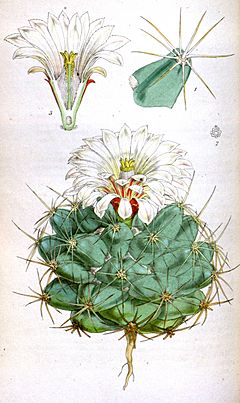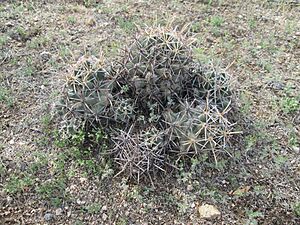Pima pineapple cactus facts for kids
Quick facts for kids Coryphantha robustispina |
|
|---|---|
 |
|
| Scientific classification | |
| Kingdom: | |
| (unranked): | |
| (unranked): | |
| (unranked): | |
| Order: | |
| Family: | |
| Subfamily: | |
| Tribe: |
Cacteae
|
| Genus: | |
| Species: |
C. robustispina
|
| Binomial name | |
| Coryphantha robustispina (Schott ex Engelm.) Britton & Rose
|
|
Coryphantha robustispina, also known as the Pima pineapple cactus, is a special type of cactus that lives in the Sonoran Desert. This plant is federally protected, meaning it's very important to keep it safe. You can mostly find it in Pima County, Arizona, but it also grows in New Mexico, Texas, and parts of Mexico.
Contents
What's in a Name?
The scientific name Coryphantha comes from two ancient Greek words. Coryphe means "head," and anthos means "flower." So, it's like saying "the plant with a flower on its head"! The second part, robustispina, means "strong spines" or "tough needles," which describes its prickly exterior.
How to Identify This Cactus
The Pima pineapple cactus usually grows by itself and has an oval shape. It has a clean grayish-green color. These cacti typically grow to be about 5–9 centimeters (2–3.5 inches) tall and 5–15 centimeters (2–6 inches) wide. However, you might find some even larger ones!
Its areolas (the small bumps where spines grow) are oval or cylinder-shaped. They have a deep groove and one or two nectar glands. The cactus has 1 to 4 central spines that can be curved or hooked. These spines are white or gray with darker tips and can be 1 to 5 centimeters (0.4–2 inches) long. It also has 6 to 16 radial spines, which are off-white and about 1 to 3 centimeters (0.4–1.2 inches) long.
When it blooms, its flowers are golden yellow, pale green, or a dull yellow color. After flowering, it produces cylindrical, green seed pods that can grow up to 5 centimeters (2 inches) long.
Where It Lives
The Coryphantha robustispina cactus is found in the United States in Arizona, New Mexico, and Texas. It also grows in Mexico, specifically in the states of Chihuahua and Sonora. This cactus is quite rare, which is why it is listed on the Federal Endangered Species list. This means it needs special protection to help it survive and thrive.
The Cactus Life Cycle
The Pima pineapple cactus has a very interesting and complicated way of reproducing. Here's how it usually works:
- Step 1: Flowering. The cactus flowers after a monsoon rain, which usually happens in July.
- Step 2: Pollination. A special type of bee fertilizes the flowers a couple of days later. The flowers only last for a short time.
- Step 3: Seed Dispersal. The seed pods must be eaten by a jack rabbit. It's important that it's a jack rabbit and not a cottontail rabbit, because a cottontail's teeth can damage the seeds.
- Step 4: Seed Protection. The seeds travel through the jack rabbit's digestive system and are then deposited on the ground in its droppings (scat). This scat helps protect the seeds.
- Step 5: Germination. Finally, a special type of termite eats the scat. This process helps the seeds to sprout and grow into new plants.
This life cycle is very complex. If any of these steps are interrupted, the plant might not be able to reproduce. However, scientists have found that seeds collected directly from the fruit can also grow into mature plants, even without going through a jack rabbit's digestive system.
See also
 In Spanish: Coryphantha robustispina para niños
In Spanish: Coryphantha robustispina para niños


